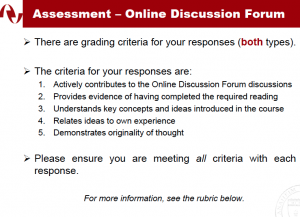Collaboration is something I never thought about when I was a student taking online courses—the classes I took over Blackboard were always very cut-and-dry: watch a PowerPoint, take some notes, respond to several posts, write a paper. While I understand that Blackboard ITSELF was very cut-and-dry—and admittedly, this was back in olden times—I wonder at the lack of collaboration within those courses. After reading Warnock’s chapter 14 and watching Janette’s video, I now think group work would have been very doable in those primitive e-classes of yore.
So, without further ado, I present my sample collaboration sequence. As I’ve yet to teach online/hybrid courses, this is all pure speculation and ideas; it’s a series I HOPE would work, but would need to be trialed and tested. My goal is to create a multi-modal, multiple-learning-pathways unit that fosters process work and scaffolding.
This would be a collaboration model I’d use in the later part of the semester for my standard English 100 course, which of course would have been translated into an OWcourse. The sequence would probably start in Week 11 or 12. This model doesn’t include PowerPoints and other lessons from me, entire-class posts, or individual work—it’s purely focused on the collaborative aspects. Here I go:
Multi-Modal Collaboration Overview
♦ The two texts they’d be working with are transcripts of Adichie’s “The Danger of a Single Story” and Shafak’s “The Politics of Fiction,” two pieces I adore and highly recommend. I think Warnock’s (149) and Janette’s shared idea to sort students into smaller groups is both logical and brilliant, and therefore I’m unashamedly copying it: the students in this assignment would be sorted into groups of five.
♦ The assignment will ask students to work together in their groups of five to fully analyze the rhetorical devices, arguments, and strategies in both pieces. The final paper for this unit (which is not collaborative but is worth mentioning) would ask for each student to individually compose a comparative analysis of both pieces. They would do this in order to assess which rhetorical devices work best (and perhaps also which are weakest) in supporting similar arguments. That aside, the group would be working on a group assignment associated with the same readings where they give a presentation (yep, an OWcourse presentation!) on how ten rhetorical devices are functioning within the two pieces. The ideal is each student would be responsible for tracing two devices: one in Adichie’s and one in Shafak’s. They’d be collaborating, sharing their ideas, and working together to build a strong final presentation. All the process work is low-stakes: all the posts, discussion, etc. they do leading up to the creation of their presentation is worth points, which rewards them for being team players. These low-stakes steps are probably worth 10 points each, rewarding and enticing, but not akin to the heavy grade value (100 points out of a 1000-point class) the final group assignment itself is worth.
Series of Activities in This Sequence
1) Discussion Board Sounding Ground Pt. 1: After the students read the two pieces and have had a good deal of class-wide instruction and primary discussion, they’d be sorted into groups of five and asked to begin by creating one 7-9 sentence post discussion the various devices they’ve found in the two pieces. They would then briefly respond to the four others’ thoughts as well. In responding to each other, my hope is they’d see which devices are more prevalent than others within each piece.

2) Google Form: From here, they’d all visit a Google form and vote on a time to synchronously (Warnock 150) meet in a (designed by me) Chatstep Chat Room meeting. There is only one synchronous meeting they’d be required to hold. (Btw: Chatstep is a really nice website used to create private and safe chatrooms. If I need to step in and moderate, I have that option). The students are free to synchronously or asynchronously talk with each other in whichever ways they like best outside of this requirement.

3) Group Chat: In their synchronous chat, they’d select which devices they’ll each be tracing and how they’ll divide up the work. They’d also vote on how to approach the final product: they can use Camtasia or any other screen-recording software to either record their individual portions all meshed together, or record or upload them all individually to their group assignment folder on Canvas. Their final presentations can be PowerPoints, Google Slides, Youtube videos, or anything else they can dream up to meet the criteria. (Nota bene: I’d like to have an actual list of media for them to select from by that point, but I’m still currently working on broadening that list ☺).
4) Group Google Docs: Each group would have two Google docs, one of Adichie’s transcript, and the other Shafak’s. These two docs would be limited to the group of five. They’d each asynchronously highlight and comment on their devices. This assignment would also require them to respond—at least one per fellow student—to each other’s comments on the same doc. This allows them to provide feedback to each other’s ideas on the actual pieces themselves. This way, they can all—as a team—see the actual examples of the devices and read each other’s thoughts on how those devices and examples are functioning.

5) Discussion Board Sounding Ground Pt. 2: They’d each post on an additional discussion board their finalized analyses of their selected devices. This assignment would, once again, ask for each student to additionally respond to at least one other peer’s ideas. This is one more chance for joint effort and group cooperation.

6) Presentation: They’d each record/upload the presentation of their devices. Again, the type of presentation is up to them: PowerPoints, Prezis, Youtube Videos, actual recordings of themselves, whatever works best for them is fine with me.*
7) Google Doc Credit Sesh: After posting their presentations, they would go onto a group Google Doc and do the following: reflect on how the assignment went, *justify their choice of media, and explain which parts of the collaboration they were responsible for. I know this might be an unpopular strategy, but as someone who was the student who always ended up with all the work, I feel this portion is vital towards a fair distribution of points.
8) AV Feedback: I’d provide the group with feedback. This step needs more thought, of course, as I’m not sure how I want to approach it. I might decide on one master recording of me going through their presentations accompanied with my audio commentary. Whatever I chose, I’d be sure to also provide them with a document listing their group grade and plenty of explanation.
So, of course, there are a few disclaimers to this sequence: first, these aren’t the only activities they’d be working on, just the collaborative ones. There would be other whole-class activities, individual assignments, lectures, and readings they’d be working on simultaneously. Second, this would take place over the course of four or five weeks. Third, I have no idea how successful this activity would be, although I have high hopes—I’d love a chance to try it out, of course!
After this unit, I now have a lot more hope and faith in the possibility of collaboration outside of just doing peer reviews—which, like Warnock, I didn’t want to belabor (149). I am in constant awe of the digital possibilities open to us nowadays and would like to incorporate other newfangled techs into this design. Please let me know if you have any suggestions!




